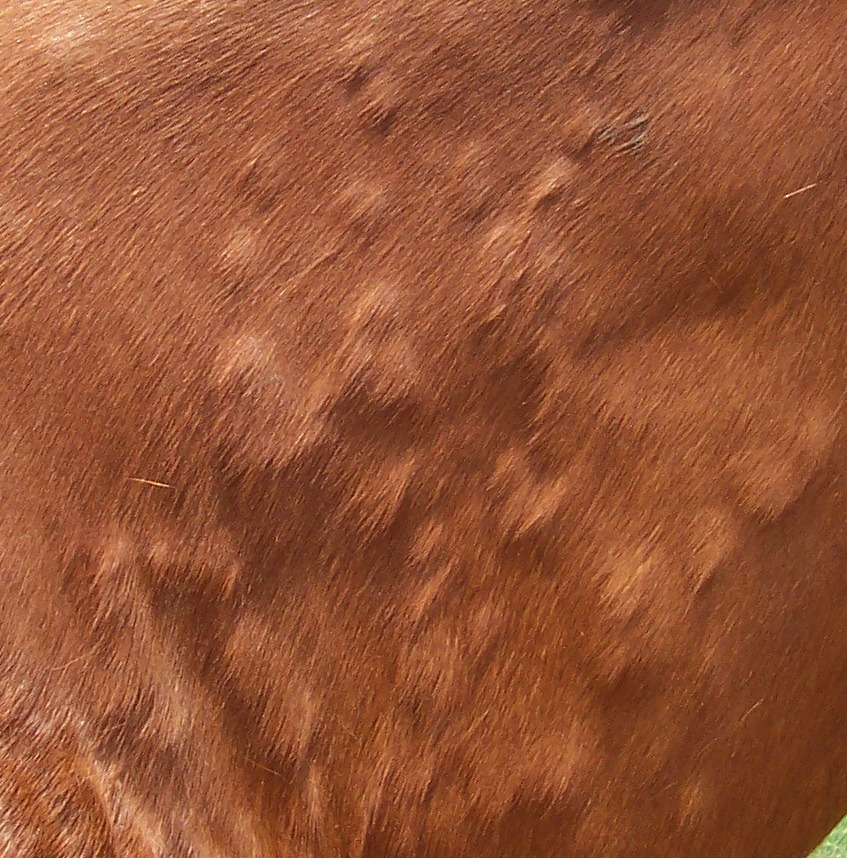by Don Blazer, Horse Courses Online

Go to the barn, look at your horse, and you will often find a lump, a bump, a scratch, or a sore. These may be found on his face, neck, shoulder, girth, back, legs, or behind the pastern. Most bumps and scrapes are minor, but if you see ringworm, rain rot, scratches or hives, then your horse has a problem and you have a duty – get busy and get rid of it!
Ringworm (frequently called girth itch) is a fungus that feeds on dead skin and hair. It doesn’t invade living tissue, although you’ll see scaly or crusty patches of skin that look somewhat like a scrape.Ringworm will cluster in dime to quarter-sized spots which will be quite irritating to your horse. It may try to scratch the area, making everything worse. You can follow conventional wisdom and bathe your horse with an iodine-based shampoo made specifically for equine fungus problems. My first choice is to use Lotrimin (anti-fungal cream for humans). The way we used to do it was mix a thin paste of “rose dust” and water and apply it to the lesion. Most rose dust products contain captan, a fungicide used to dust plants. It works quite well. Ringworm is highly contagious so disinfect blankets, towels, grooming tools, saddle pads and everything else that might come in contact with other horses. You can get ringworm, too, so be sure to wash with an iodine-based soap before touching your nose. Also wash before handling another horse.
Scratches is seen quite often when rain and winter weather arrive. Also known as greasy heel or mud fever, scratches can be very painful for your horse and even cause lameness. Scratches is an infection, with swelling, inflammation and open sores on the back of the pastern. While it can be caused by a number of things, the most common cause is chronically muddy, wet and unsanitary conditions – the kind of conditions found in small pens. The most effective treatment I’ve seen is the use of SMZ/TMP (sulfadiazine/trimethoprim) tablets made into a paste and applied to the cleaned and dried infected area. You can get the tablets from your veterinarian and apply the paste yourself. Be careful, sometimes scratches are so painful your otherwise tolerant horse may become a kicker.Wash the scratches with an antiseptic soap or an antibacterial shampoo, leave the soap or shampoo on for five to 10 minutes, then rinse and dry. “Clean and dry” are the key elements to stop scratches. They can take up to two weeks to heal and will return if the unsanitary environment is not addressed.
Rain rot is caused by bacteria which attacks moist skin. Biting insects can spread it. Rain rot can get so bad that big hunks of hair will come out leaving ulcerated sores. While rain rot does not usually cause a lot of itching, it can cause the horse to be depressed and lose his appetite. Rain rot is usually seen across the back and rump, where the horse gets the most rain. To make treatment more effective, it is a good idea to clip the hair around the sores. Again, be careful as clipping can cause pain. Wash the contaminated area with an iodine based scrub or an antiseptic shampoo. You may have to treat the conditions several times a day for a week or more.
Hives are an allergic reaction that can be caused by dusts, molds, biting insects, weeds or even a change in feed. You’ll feel terrible about what you think your horse is suffering, but he probably isn’t too uncomfortable. Give him a bath with cool water, and while you are washing him think about what you have changed in his environment. It could be new bedding (shavings or straw), a new fly repellent, new feed or new treats. In any case, if the hives don’t disappear within 24 hours consult your vet. Hives can cause depression, severe itching and loss of appetite. Generally your vet will treat the condition with steroids or antihistamines.
Ring worm, rain rot, scratches and hives may not be more than skin deep, but they are still no fun for your horse. And they can definitely put a damper on your riding schedule.
Education powers up your earning potential, boosts confidence and benefits all horses. Visit www.horsecoursesonline.com to earn certification as a horse trainer, riding instructor or stable manager.
Published in September 2015 Issue

Don Blazer developed and taught the course The Business of Making Money With Horses for www.horsecoursesonline.com, the worldwide leader in online equine curriculum. Also the author of the syndicated columns “A Horse, of Course” and ”Making Money with Horses”, Don lost his battle with lung cancer on April 7, 2014. However, the horse community is grateful that his wisdom lives on through the wealth of books and articles he wrote over the years.




